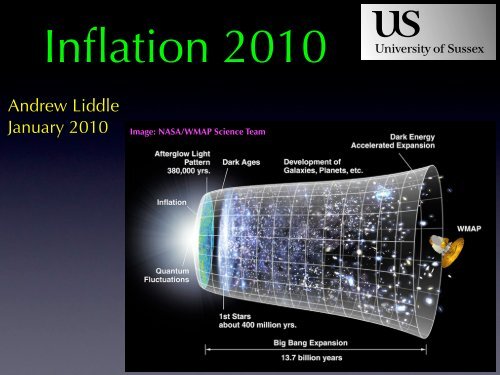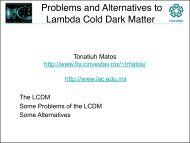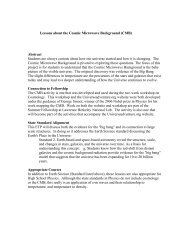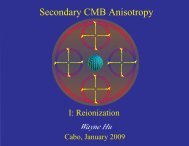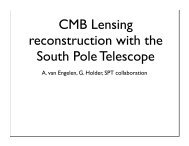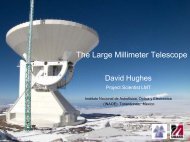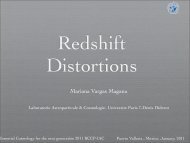1. Basics of Inflationary Cosmology - Berkeley Center for ...
1. Basics of Inflationary Cosmology - Berkeley Center for ...
1. Basics of Inflationary Cosmology - Berkeley Center for ...
You also want an ePaper? Increase the reach of your titles
YUMPU automatically turns print PDFs into web optimized ePapers that Google loves.
Inflation 2010<br />
Andrew Liddle<br />
January 2010 Image: NASA/WMAP Science Team
Inflation 2010<br />
Andrew Liddle<br />
January 2010 Image: NASA/WMAP Science Team
Lecture plan<br />
Lecture 1: <strong>Cosmology</strong> overview<br />
<strong>Basics</strong> <strong>of</strong> inflationary cosmology<br />
Lecture 2: Observational status <strong>of</strong> inflation<br />
Lecture 3: The inflation-building toolkit.
COBE<br />
WMAP<br />
Cosmological overview<br />
Millennium<br />
simulation
COBE<br />
WMAP<br />
Cosmological overview<br />
Millennium<br />
simulation
COBE<br />
WMAP<br />
Cosmological overview<br />
Millennium<br />
simulation
COBE<br />
WMAP<br />
Cosmological overview<br />
Millennium<br />
simulation
What cosmological model?<br />
These are the principles and physical laws underpinning the Universe.
What cosmological model?<br />
These are the principles and physical laws underpinning the Universe.<br />
Hot big bang cosmology<br />
Describes the global properties <strong>of</strong> the Universe, its<br />
expansion, and its material content.
What cosmological model?<br />
These are the principles and physical laws underpinning the Universe.<br />
Hot big bang cosmology<br />
Describes the global properties <strong>of</strong> the Universe, its<br />
expansion, and its material content.<br />
Structure <strong>for</strong>mation by gravitational instability<br />
Describes the growth <strong>of</strong> structure from initially-small<br />
irregularities. Gravity <strong>for</strong> the initial collapse, lots <strong>of</strong> other<br />
physics in the details.
What cosmological model?<br />
These are the principles and physical laws underpinning the Universe.<br />
Hot big bang cosmology<br />
Describes the global properties <strong>of</strong> the Universe, its<br />
expansion, and its material content.<br />
Structure <strong>for</strong>mation by gravitational instability<br />
Describes the growth <strong>of</strong> structure from initially-small<br />
irregularities. Gravity <strong>for</strong> the initial collapse, lots <strong>of</strong> other<br />
physics in the details.<br />
<strong>Inflationary</strong> cosmology<br />
The leading candidate theory <strong>for</strong> explaining where those<br />
initial irregularities came from: quantum fluctuations<br />
during rapid expansion <strong>of</strong> the young Universe.
What cosmological parameters?<br />
The standard assumption is that the present Universe contains<br />
five types <strong>of</strong> material.<br />
Baryons (ie protons, neutrons and electrons)<br />
Radiation (photons)<br />
Neutrinos<br />
Dark matter<br />
Dark energy (eg cosmological constant)<br />
The sum <strong>of</strong> their densities, plus the expansion rate, determines the<br />
spatial curvature, which nowadays is usually assumed to vanish.
What cosmological parameters?<br />
The standard assumption is that the present Universe contains<br />
five types <strong>of</strong> material.<br />
Baryons (ie protons, neutrons and electrons)<br />
Radiation (photons)<br />
Neutrinos<br />
Dark matter<br />
Dark energy (eg cosmological constant)<br />
The sum <strong>of</strong> their densities, plus the expansion rate, determines the<br />
spatial curvature, which nowadays is usually assumed to vanish.<br />
Along with these, we need the parameters describing the<br />
density perturbations in the Universe.
What cosmological parameters?<br />
The standard assumption is that the present Universe contains<br />
five types <strong>of</strong> material.<br />
Baryons (ie protons, neutrons and electrons)<br />
Radiation (photons)<br />
Neutrinos<br />
Dark matter<br />
Dark energy (eg cosmological constant)<br />
The sum <strong>of</strong> their densities, plus the expansion rate, determines the<br />
spatial curvature, which nowadays is usually assumed to vanish.<br />
Along with these, we need the parameters describing the<br />
density perturbations in the Universe.<br />
Plus the theoretical technology necessary to develop<br />
observational predictions based on the model assumptions.
Some cosmological questions
Some cosmological questions<br />
What is the fundamental nature <strong>of</strong> the dark matter?
Some cosmological questions<br />
What is the fundamental nature <strong>of</strong> the dark matter?<br />
Is the dark energy a cosmological constant?<br />
Is it due to a new <strong>for</strong>m <strong>of</strong> matter or a new theory <strong>of</strong> gravity?<br />
Does it evolve?
Some cosmological questions<br />
What is the fundamental nature <strong>of</strong> the dark matter?<br />
Is the dark energy a cosmological constant?<br />
Is it due to a new <strong>for</strong>m <strong>of</strong> matter or a new theory <strong>of</strong> gravity?<br />
Does it evolve?<br />
Are there connections amongst the dark sector components?
Some cosmological questions<br />
What is the fundamental nature <strong>of</strong> the dark matter?<br />
Is the dark energy a cosmological constant?<br />
Is it due to a new <strong>for</strong>m <strong>of</strong> matter or a new theory <strong>of</strong> gravity?<br />
Does it evolve?<br />
Are there connections amongst the dark sector components?<br />
Can the effects <strong>of</strong> neutrino masses influence cosmology?
Some cosmological questions<br />
What is the fundamental nature <strong>of</strong> the dark matter?<br />
Is the dark energy a cosmological constant?<br />
Is it due to a new <strong>for</strong>m <strong>of</strong> matter or a new theory <strong>of</strong> gravity?<br />
Does it evolve?<br />
Are there connections amongst the dark sector components?<br />
Can the effects <strong>of</strong> neutrino masses influence cosmology?<br />
Are primordial perturbations gaussian or not?
Some cosmological questions<br />
What is the fundamental nature <strong>of</strong> the dark matter?<br />
Is the dark energy a cosmological constant?<br />
Is it due to a new <strong>for</strong>m <strong>of</strong> matter or a new theory <strong>of</strong> gravity?<br />
Does it evolve?<br />
Are there connections amongst the dark sector components?<br />
Can the effects <strong>of</strong> neutrino masses influence cosmology?<br />
Are primordial perturbations gaussian or not?<br />
Are primordial perturbations purely <strong>of</strong> adiabatic scalar type?
Some cosmological questions<br />
What is the fundamental nature <strong>of</strong> the dark matter?<br />
Is the dark energy a cosmological constant?<br />
Is it due to a new <strong>for</strong>m <strong>of</strong> matter or a new theory <strong>of</strong> gravity?<br />
Does it evolve?<br />
Are there connections amongst the dark sector components?<br />
Can the effects <strong>of</strong> neutrino masses influence cosmology?<br />
Are primordial perturbations gaussian or not?<br />
Are primordial perturbations purely <strong>of</strong> adiabatic scalar type?<br />
Can fundamental properties <strong>of</strong> the Universe be predicted by<br />
theory at all?
Lecture 1<br />
The basics <strong>of</strong> inflationary cosmology
Inflation is ...
Inflation is ...<br />
A prolonged period <strong>of</strong> accelerated expansion in the very early<br />
Universe,
Inflation is ...<br />
A prolonged period <strong>of</strong> accelerated expansion in the very early<br />
Universe,<br />
which explains why the Universe is approximately homogeneous<br />
and spatially-flat,
Inflation is ...<br />
A prolonged period <strong>of</strong> accelerated expansion in the very early<br />
Universe,<br />
which explains why the Universe is approximately homogeneous<br />
and spatially-flat,<br />
may explain the absence <strong>of</strong> relic particles predicted by<br />
fundamental physics,
Inflation is ...<br />
A prolonged period <strong>of</strong> accelerated expansion in the very early<br />
Universe,<br />
which explains why the Universe is approximately homogeneous<br />
and spatially-flat,<br />
may explain the absence <strong>of</strong> relic particles predicted by<br />
fundamental physics,<br />
and is the leading paradigm <strong>for</strong> explaining the observed<br />
inhomogeneities in the Universe.
WMAP 5-year<br />
map<br />
Inflation is ...<br />
A prolonged period <strong>of</strong> accelerated expansion in the very early<br />
Universe,<br />
which explains why the Universe is approximately homogeneous<br />
and spatially-flat,<br />
may explain the absence <strong>of</strong> relic particles predicted by<br />
fundamental physics,<br />
and is the leading paradigm <strong>for</strong> explaining the observed<br />
inhomogeneities in the Universe.
Conditions <strong>for</strong> acceleration<br />
The equations <strong>of</strong> motion are
Conditions <strong>for</strong> acceleration<br />
The equations <strong>of</strong> motion are<br />
2<br />
H 2 <br />
˙a<br />
≡ =<br />
a<br />
8πG kc2<br />
ρ −<br />
3 a2 <br />
˙ρ + 3H ρ + p<br />
c2 <br />
= 0
Conditions <strong>for</strong> acceleration<br />
The equations <strong>of</strong> motion are<br />
2<br />
H 2 <br />
˙a<br />
≡ =<br />
a<br />
8πG kc2<br />
ρ −<br />
3 a2 <br />
˙ρ + 3H ρ + p<br />
c2 <br />
= 0<br />
They can be combined as
Conditions <strong>for</strong> acceleration<br />
The equations <strong>of</strong> motion are<br />
2<br />
H 2 <br />
˙a<br />
≡ =<br />
a<br />
8πG kc2<br />
ρ −<br />
3 a2 <br />
˙ρ + 3H ρ + p<br />
c2 <br />
= 0<br />
They can be combined as<br />
ä<br />
a<br />
= −4πG<br />
3<br />
<br />
ρ + 3p<br />
c2
Conditions <strong>for</strong> acceleration<br />
The equations <strong>of</strong> motion are<br />
2<br />
H 2 <br />
˙a<br />
≡ =<br />
a<br />
8πG kc2<br />
ρ −<br />
3 a2 <br />
˙ρ + 3H ρ + p<br />
c2 <br />
= 0<br />
They can be combined as<br />
ä<br />
a<br />
= −4πG<br />
3<br />
<br />
ρ + 3p<br />
c 2<br />
and so acceleration requires p < −ρc 2 /3
What causes inflation?<br />
The condition is satisfied<br />
provided<br />
ä > 0<br />
ρ + 3p < 0
What causes inflation?<br />
The condition is satisfied<br />
provided<br />
ä > 0<br />
ρ + 3p < 0<br />
The simplest way <strong>for</strong> this to take place is <strong>for</strong><br />
the Universe to become dominated by the<br />
potential energy <strong>of</strong> a scalar field. In<br />
fundamental physics, such a field describes<br />
spin-zero particles (eg the Higgs).
What causes inflation?<br />
The condition is satisfied<br />
provided<br />
ä > 0<br />
ρ + 3p < 0<br />
The simplest way <strong>for</strong> this to take place is <strong>for</strong><br />
the Universe to become dominated by the<br />
potential energy <strong>of</strong> a scalar field. In<br />
fundamental physics, such a field describes<br />
spin-zero particles (eg the Higgs).<br />
V (φ)<br />
φ
What causes inflation?<br />
The condition is satisfied<br />
provided<br />
ä > 0<br />
ρ + 3p < 0<br />
The simplest way <strong>for</strong> this to take place is <strong>for</strong><br />
the Universe to become dominated by the<br />
potential energy <strong>of</strong> a scalar field. In<br />
fundamental physics, such a field describes<br />
spin-zero particles (eg the Higgs).<br />
V (φ)<br />
˙φ 2<br />
ρ=V (φ)+ 1<br />
2<br />
p=−V (φ)+ 1<br />
2<br />
˙φ 2<br />
φ
What causes inflation?<br />
The condition is satisfied<br />
provided<br />
ä > 0<br />
ρ + 3p < 0<br />
The simplest way <strong>for</strong> this to take place is <strong>for</strong><br />
the Universe to become dominated by the<br />
potential energy <strong>of</strong> a scalar field. In<br />
fundamental physics, such a field describes<br />
spin-zero particles (eg the Higgs).<br />
For now I will assume there is just a single<br />
field, though many models have more.<br />
V (φ)<br />
˙φ 2<br />
ρ=V (φ)+ 1<br />
2<br />
p=−V (φ)+ 1<br />
2<br />
˙φ 2<br />
φ
The scalar field potential<br />
In the simplest scenarios, the potential<br />
energy is the only quantity which needs<br />
to be specified, and it describes the<br />
properties <strong>of</strong> the scalar field.<br />
V (φ)<br />
˙φ 2<br />
ρ=V (φ)+ 1<br />
2<br />
p=−V (φ)+ 1<br />
2<br />
˙φ 2<br />
φ
The scalar field potential<br />
In the simplest scenarios, the potential<br />
energy is the only quantity which needs<br />
to be specified, and it describes the<br />
properties <strong>of</strong> the scalar field.<br />
Un<strong>for</strong>tunately no fundamental scalar field<br />
has ever been observed, though particle<br />
theories predicts large numbers <strong>of</strong> them.<br />
In cosmology, we aim to constrain the<br />
potential using observations.<br />
V (φ)<br />
˙φ 2<br />
ρ=V (φ)+ 1<br />
2<br />
p=−V (φ)+ 1<br />
2<br />
˙φ 2<br />
φ
Inflation and perturbations<br />
The main motivation <strong>for</strong> being interested in inflation is that it<br />
leads to a perturbed Universe. During inflation, quantum<br />
fluctuations are imprinted on the Universe.
Inflation and perturbations<br />
The main motivation <strong>for</strong> being interested in inflation is that it<br />
leads to a perturbed Universe. During inflation, quantum<br />
fluctuations are imprinted on the Universe.<br />
Scalar field fluctuations<br />
Lead to scalar metric perturbations<br />
Cause gravitational collapse to <strong>for</strong>m structures<br />
Gravitational wave perturbations<br />
Not associated with gravitational collapse but may<br />
influence the CMB.
Analogies
Analogies<br />
The creation <strong>of</strong> density perturbations during inflation has several<br />
analogues in other areas <strong>of</strong> physics:
Analogies<br />
The creation <strong>of</strong> density perturbations during inflation has several<br />
analogues in other areas <strong>of</strong> physics:<br />
Hawking radiation from a black hole is very similar, with the event<br />
horizon taking the place <strong>of</strong> the particle horizon in the case <strong>of</strong> inflation.
Analogies<br />
The creation <strong>of</strong> density perturbations during inflation has several<br />
analogues in other areas <strong>of</strong> physics:<br />
Hawking radiation from a black hole is very similar, with the event<br />
horizon taking the place <strong>of</strong> the particle horizon in the case <strong>of</strong> inflation.<br />
Perhaps more interestingly, there is an analogous situation in<br />
electrodynamics.
Analogies<br />
The creation <strong>of</strong> density perturbations during inflation has several<br />
analogues in other areas <strong>of</strong> physics:<br />
Hawking radiation from a black hole is very similar, with the event<br />
horizon taking the place <strong>of</strong> the particle horizon in the case <strong>of</strong> inflation.<br />
Perhaps more interestingly, there is an analogous situation in<br />
electrodynamics.<br />
+ve -ve
Analogies<br />
The creation <strong>of</strong> density perturbations during inflation has several<br />
analogues in other areas <strong>of</strong> physics:<br />
Hawking radiation from a black hole is very similar, with the event<br />
horizon taking the place <strong>of</strong> the particle horizon in the case <strong>of</strong> inflation.<br />
Perhaps more interestingly, there is an analogous situation in<br />
electrodynamics.<br />
uni<strong>for</strong>m electric field<br />
+ve -ve
Analogies<br />
The creation <strong>of</strong> density perturbations during inflation has several<br />
analogues in other areas <strong>of</strong> physics:<br />
Hawking radiation from a black hole is very similar, with the event<br />
horizon taking the place <strong>of</strong> the particle horizon in the case <strong>of</strong> inflation.<br />
Perhaps more interestingly, there is an analogous situation in<br />
electrodynamics.<br />
uni<strong>for</strong>m electric field<br />
+ve -ve<br />
positron<br />
electron
Analogies<br />
The creation <strong>of</strong> density perturbations during inflation has several<br />
analogues in other areas <strong>of</strong> physics:<br />
Hawking radiation from a black hole is very similar, with the event<br />
horizon taking the place <strong>of</strong> the particle horizon in the case <strong>of</strong> inflation.<br />
Perhaps more interestingly, there is an analogous situation in<br />
electrodynamics.<br />
uni<strong>for</strong>m electric field<br />
+ve -ve<br />
positron<br />
electron
Analogies<br />
The creation <strong>of</strong> density perturbations during inflation has several<br />
analogues in other areas <strong>of</strong> physics:<br />
Hawking radiation from a black hole is very similar, with the event<br />
horizon taking the place <strong>of</strong> the particle horizon in the case <strong>of</strong> inflation.<br />
Perhaps more interestingly, there is an analogous situation in<br />
electrodynamics.<br />
The pair<br />
production breaks<br />
the initial<br />
homogeneity.<br />
uni<strong>for</strong>m electric field<br />
+ve -ve<br />
positron<br />
electron
Single-field inflation predictions (Liddle & Lyth 1992)
Single-field inflation predictions (Liddle & Lyth 1992)<br />
Slow-roll parameters<br />
ε = 1<br />
<br />
V ′ (φ)<br />
16πG V (φ<br />
η = 1 V<br />
8πG<br />
′′ (φ)<br />
V (φ)<br />
2<br />
′≡d/dφ
Single-field inflation predictions (Liddle & Lyth 1992)<br />
Slow-roll parameters<br />
ε = 1<br />
<br />
V ′ (φ)<br />
16πG V (φ<br />
η = 1 V<br />
8πG<br />
′′ (φ)<br />
V (φ)<br />
Having inflation requires that these are small ε ≪ 1;|η|≪ 1<br />
2<br />
′≡d/dφ
Single-field inflation predictions (Liddle & Lyth 1992)<br />
Slow-roll parameters<br />
ε = 1<br />
<br />
V ′ (φ)<br />
16πG V (φ<br />
η = 1 V<br />
8πG<br />
′′ (φ)<br />
V (φ)<br />
Having inflation requires that these are small ε ≪ 1;|η|≪ 1<br />
Density perturbations δ 2 H(k) δ 2 H(k0)<br />
δ 2 H(k0) 32<br />
75<br />
V<br />
G −2<br />
k<br />
1<br />
ε<br />
k0<br />
2<br />
n−1<br />
′≡d/dφ<br />
n − 1 = 6ε − 2η
Single-field inflation predictions (Liddle & Lyth 1992)<br />
Slow-roll parameters<br />
ε = 1<br />
<br />
V ′ (φ)<br />
16πG V (φ<br />
η = 1 V<br />
8πG<br />
′′ (φ)<br />
V (φ)<br />
Having inflation requires that these are small ε ≪ 1;|η|≪ 1<br />
Density perturbations δ 2 H(k) δ 2 H(k0)<br />
NB: several different normalization<br />
conventions are in use.<br />
δ 2 H(k0) 32<br />
75<br />
V<br />
G −2<br />
k<br />
1<br />
ε<br />
k0<br />
2<br />
n−1<br />
′≡d/dφ<br />
n − 1 = 6ε − 2η
Single-field inflation predictions (Liddle & Lyth 1992)<br />
Slow-roll parameters<br />
ε = 1<br />
<br />
V ′ (φ)<br />
16πG V (φ<br />
η = 1 V<br />
8πG<br />
′′ (φ)<br />
V (φ)<br />
Having inflation requires that these are small ε ≪ 1;|η|≪ 1<br />
Density perturbations δ 2 H(k) δ 2 H(k0)<br />
NB: several different normalization<br />
conventions are in use.<br />
δ 2 H(k0) 32<br />
75<br />
V<br />
G −2<br />
k<br />
1<br />
ε<br />
k0<br />
2<br />
n−1<br />
′≡d/dφ<br />
n − 1 = 6ε − 2η<br />
Gravitational waves r = 16ε nG = −2ε = − r<br />
8
Other inflationary perturbations<br />
It is a very reasonable working hypothesis that the single-field<br />
paradigm holds, and much work goes into constraining inflationary<br />
models <strong>of</strong> this type. But there is a broader phenomenology:
Other inflationary perturbations
Other inflationary perturbations<br />
Multi-field models.
Other inflationary perturbations<br />
Multi-field models.<br />
Perturbations in additional fields can give rise to isocurvature<br />
perturbations, depending on how inflationary degrees <strong>of</strong> freedom map to<br />
post-inflationary ones. Non-gaussianity also possible but requires tuning.
Other inflationary perturbations<br />
Multi-field models.<br />
Perturbations in additional fields can give rise to isocurvature<br />
perturbations, depending on how inflationary degrees <strong>of</strong> freedom map to<br />
post-inflationary ones. Non-gaussianity also possible but requires tuning.<br />
Non-standard kinetic terms (eg DBI fields)
Other inflationary perturbations<br />
Multi-field models.<br />
Perturbations in additional fields can give rise to isocurvature<br />
perturbations, depending on how inflationary degrees <strong>of</strong> freedom map to<br />
post-inflationary ones. Non-gaussianity also possible but requires tuning.<br />
Non-standard kinetic terms (eg DBI fields)<br />
These can give a small perturbation sound speed, leading to large nongaussianity.<br />
Might arise naturally in string theories.
Other inflationary perturbations<br />
Multi-field models.<br />
Perturbations in additional fields can give rise to isocurvature<br />
perturbations, depending on how inflationary degrees <strong>of</strong> freedom map to<br />
post-inflationary ones. Non-gaussianity also possible but requires tuning.<br />
Non-standard kinetic terms (eg DBI fields)<br />
These can give a small perturbation sound speed, leading to large nongaussianity.<br />
Might arise naturally in string theories.<br />
Generating perturbations after inflation: post-process<br />
perturbations acquired in a different field.
Other inflationary perturbations<br />
Multi-field models.<br />
Perturbations in additional fields can give rise to isocurvature<br />
perturbations, depending on how inflationary degrees <strong>of</strong> freedom map to<br />
post-inflationary ones. Non-gaussianity also possible but requires tuning.<br />
Non-standard kinetic terms (eg DBI fields)<br />
These can give a small perturbation sound speed, leading to large nongaussianity.<br />
Might arise naturally in string theories.<br />
Generating perturbations after inflation: post-process<br />
perturbations acquired in a different field.<br />
Curvaton mechanism: auxiliary field develops a significant<br />
density then decays. Large non-gaussianity possible if sub-dominant<br />
at decay.
Other inflationary perturbations<br />
Multi-field models.<br />
Perturbations in additional fields can give rise to isocurvature<br />
perturbations, depending on how inflationary degrees <strong>of</strong> freedom map to<br />
post-inflationary ones. Non-gaussianity also possible but requires tuning.<br />
Non-standard kinetic terms (eg DBI fields)<br />
These can give a small perturbation sound speed, leading to large nongaussianity.<br />
Might arise naturally in string theories.<br />
Generating perturbations after inflation: post-process<br />
perturbations acquired in a different field.<br />
Curvaton mechanism: auxiliary field develops a significant<br />
density then decays. Large non-gaussianity possible if sub-dominant<br />
at decay.<br />
Inhomogeneous reheating: Auxiliary field modulates the decay<br />
<strong>of</strong> the inflaton into conventional material.


